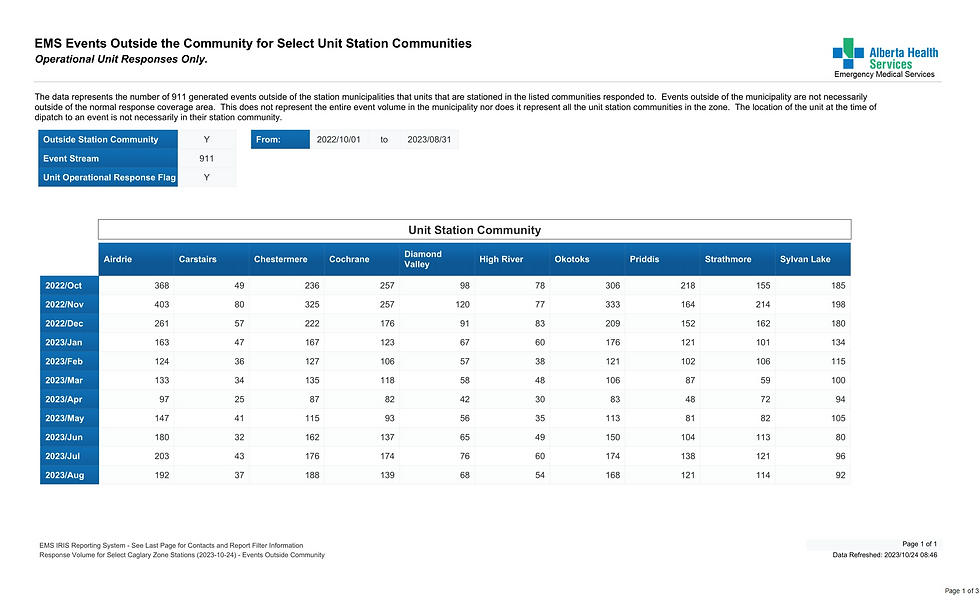Smoke and mirrors
- ambulanceman4
- Apr 2, 2024
- 4 min read
Updated: Apr 2, 2024

Within Alberta Health Services ranks, paramedics have joked about the former Chief Paramedic's notorious use of the idea that the closest available ambulance will respond. He parroted it, the paramedics laughed, and on it went. This was his, and Alberta Health Services', way to redirect attention from a broken and sick system that could not hold up to the strain. Someone would call for an ambulance in downtown Calgary and get their response from High River. So, though technically true, it was equally disingenuous. This underscores the leadership mantra of AHS EMS senior leadership.
In the years prior to COVID, call volume in Alberta, by the Chief Paramedic's own admission, was steadily increasing:
One might conclude from this reality that resources would be added to the AHS EMS fleet, although that was not the case. Under the tutelage of various governments, the NDP included, there was no major expansion of EMS resources in Alberta. Ironically, under an NDP government, a computer system touted as a way to better utilize EMS resources with predictive dispatching in mind was introduced as a means to minimize the need for more EMS resources. This system, called Optima, is still in place and, according to countless frontline staff accounts, only contributes to ever-increasing staff burnout and reduction in overall EMS resources. This was perfectly encompassed in an opinion piece submitted to the CBC:
In the same interview with former Chief Paramedic Daren Sandbeck, he underscored that the pandemic ushered in a significant uptick in call volume province-wide. He hides behind a screen, as he did before, saying this is a North American phenomenon. Worse, AHS EMS peddled another sick catchphrase, 'people returning to normal levels of activity,' rolled out widely and often:
https://www.cbc.ca/news/canada/calgary/calgary-patients-emergency-room-hallways-paramedics-1.6321833
This was disingenuous when combined with two major considerations. One being that the system had never expanded previously to COVID to relieve some of that pressure, and the second being very few innovative ways to reduce pressures on the EMS system were being introduced. Although AHS senior leadership was happy to lie, for instance in this CBC article:
Where they say that EMS crews could take patients to Urgent Care Centers, a practice that had been in place for several years before this story was ever published. Furthermore, was this release created by the province and AHS EMS:
The big take away, there was no second level of triage added in 2020 when this was made, though the former chief Paramedic calls it “an important improvement”, “or if alternate forms of transportation is more appropriate”? To date there is no alternate form of transportation that is made available. He carries on to speak about the role of the community Paramedics, the same program that had been in place years before the pandemic started. Stretcher vans were in place for near a decade now, and the bus? The bus is never used, sits idol somewhere in Edmonton. Misdirection. Smoke and mirrors. Lies.
Today, AHS leadership tours towns throughout the Calgary Zone to drum up support for their success, employing fancy words, statistics, and figures brought by the ringleaders of the circus in senior management. But what are they really saying when they come to town? Let's examine the problem as thoroughly as possible.
The system that AHS created was flawed from inception. It contains a borderless component, which AHS EMS senior leadership holds up as a strength, a crown jewel if you will. However, what it really is, as has been alluded to before, is a sick game of musical chairs, where rural communities sacrifice their ambulances on the altar of the borderless model. AHS EMS Leadership assures these communities that although their ambulances may be given to Calgary, Calgary will reciprocate by providing ambulances to them. Is this a fair trade?
With the aforementioned data available, one can surmise that in a given month, ambulances from various communities are responding to calls outside of their own communities at a significant and sustained rate. So, one might surmise from this data that the inverse would be true: ambulances from outside the community should be commensurate with this trend. If one makes this assumption, they would be incorrect. Often, the numbers are so lopsided that one might even wonder, "What are these trucks doing?" Well, given this data, there is no accounting for one major variable: how much of that volume is being carried in Calgary. This has been discussed in previous posts, but it suggests that the borderless system is a net benefit to Calgary and a liability to every other municipality.
The borderless system is not the only culprit of the problems faced by rural communities. However, when AHS leadership stands in front of your councils, they will tell them that their response times have improved, ambulances are getting to patients faster, and the ill and injured are being better served. They will not tell you that they have achieved this through their disingenuous practice of relocation, known colloquially as "flexing." The question is, when they come to town to proclaim their success, which community loses out?
If they lied then, what makes us think they are not lying now?





Comments